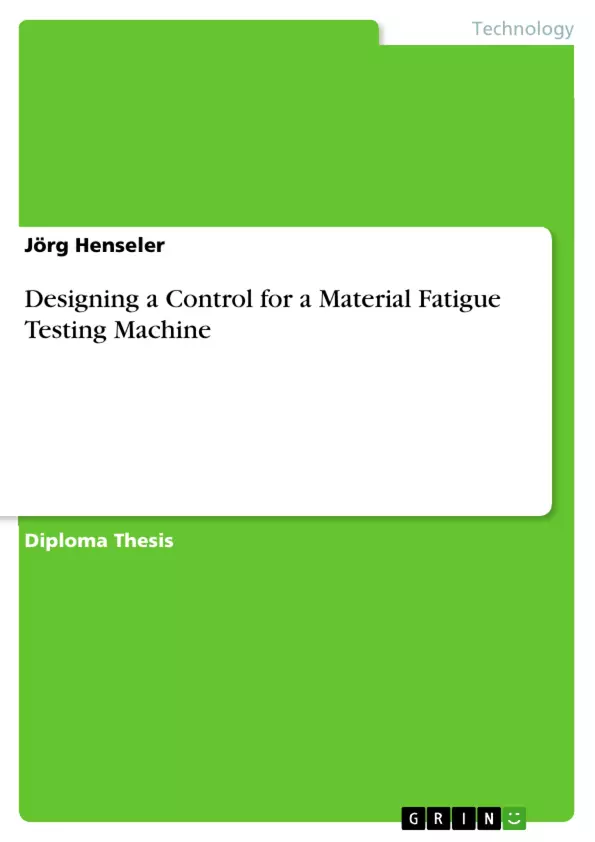PROJECT DESCRIPTION
One main field of activity of the Department of Mechanical Engineering and Material Science at the Escuela Superior de Ingenieros de Sevilla is material fatigue testing. In order to evaluate material characteristics under specified conditions, material probes are outset to biaxial movements, i.e.
traction or pressure, and
torsion.
The machines for this particular application typically use hydraulics for the power generation; the exact movement is achieved by servo-ventils. Industrial manufacturers demand at least 300.000 € for building a machine like that. This appears very expensive, keeping in mind the very basic task of the machine. Whereas a university of western industrialized countries may bear inversions like that, for universities of third world it is hardly possible to procure such a machine.
This was the motivation for the Department of Mechanical Engineering and Material Science at the Escuela Superior de Ingenieros de Sevilla to start a project in order to find a cheap as well as reliable solution for biaxial material fatigue testing.
[...]
Inhaltsverzeichnis (Table of Contents)
- Chapter 1: Project description
- Chapter 2: Main concept
- Chapter 3: Stepper Motors
- 3.1 Types
- 3.1.1 Variable Reluctance Motors
- 3.1.2 Unipolar Motors
- 3.1.3 Bipolar Motors
- 3.1.4 Multiphase Motors
- 3.2 Stepper Motor Parameters
- 3.3 Characteristics of the particular motors chosen..
- 3.1 Types
- Chapter 4: Low-level Control
- 4.1 H-Bridge
- 4.1.1 Switching elements: IGBT vs. MOSFET
- 4.1.2 Low-side Switch
- 4.1.3 High-side Switch.
- 4.1.4 Circuit design of the H-Bridge
- 4.2 Short Circuit Avoidance
- 4.3 Current Control
- 4.3.1 Pulse Width Modulation
- 4.3.2 The 555 timer circuit..
- 4.3.3 Reference Voltage.
- 4.1 H-Bridge
- Chapter 5: Mid-level Control
- 5.1 Moore Machine
- 5.2 Step Synthesis
- 5.3 Sequential Logic
- 5.4 Reset and Enable.
- 5.5 Interface.
- Chapter 6: High-level Control
- 6.1 Timing Devices
- 6.1.1 Interrupts
- 6.1.2 Timing Hardware
- 6.1.3 Timing Routines
- 6.1.3.1 The Procedure SetTimerSpeed
- 6.1.3.2 The Function GrabTimer
- 6.1.3.3 The Procedure SetTimerHandler
- 6.1.3.4 The Procedure InternalHandler
- 6.1.3.5 The Procedure DisableHandler
- 6.1.3.6 The Procedure NormTimerSpeed
- 6.1.3.7 The Procedure ResetTimer.
- 6.2 I/O-Management
- 6.2.1 Developing an ISA I/O-Card
- 6.2.2 The Parallel Port
- 6.2.3 I/O-Routines
- 6.2.3.1 The Procedure MotorWrite
- 6.2.3.2 The Procedures Motor1 Move and Motor2Move
- 6.3 Control Routines
- 6.1 Timing Devices
- Chapter 7: Human Machine Interface:
- 7.1 Turbo Vision
- 7.2 The TFatigueControl Object
- 7.2.1 Desktop and Menu Design
- 7.2.2 Options-Window
Zielsetzung und Themenschwerpunkte (Objectives and Key Themes)
This thesis documents the design and development of a control system for a biaxial material fatigue testing machine. The goal was to develop a control system that allows for precise control of the stepper motors that drive the machine's axes.
- Stepper Motor Control
- Low-Level Control Circuitry (H-Bridge, Current Control)
- Mid-Level Control (Moore Machine, Sequential Logic)
- High-Level Control (Timing, I/O-Management, Control Routines)
- Human Machine Interface (Turbo Vision)
Zusammenfassung der Kapitel (Chapter Summaries)
- Chapter 1: This chapter provides an overview of the material fatigue testing machine and its purpose. It outlines the project's scope and the motivation behind the development of a new control system.
- Chapter 2: This chapter describes the overall concept of the control system, focusing on the relationship between the machine's physical components and the control system's different levels.
- Chapter 3: This chapter discusses the selection of stepper motors as the actuators for the machine. It delves into different types of stepper motors, their characteristics, and the parameters considered for the project.
- Chapter 4: This chapter covers the design of the low-level control circuitry, specifically the H-Bridge, switching elements, and current control techniques. It explains the importance of short circuit avoidance and details the implementation of pulse width modulation for current control.
- Chapter 5: This chapter focuses on the mid-level control system, including the use of a Moore machine for state management and the design of sequential logic for controlling the stepper motor's movement. It also discusses the integration of different control elements and the communication between the low-level and mid-level control systems.
- Chapter 6: This chapter explores the design and implementation of the high-level control system. It examines the use of interrupts for timing and the development of an ISA I/O-card for managing input and output operations. The chapter also includes details about the control routines and the interface between the high-level control system and the machine's physical components.
- Chapter 7: This chapter describes the Human Machine Interface (HMI) of the control system, using Turbo Vision to develop a user-friendly graphical interface. It outlines the design of the desktop, menu system, and options window.
Schlüsselwörter (Keywords)
The main keywords of this thesis are: material fatigue testing, stepper motor control, H-Bridge, pulse width modulation, Moore machine, sequential logic, high-level control, I/O-management, ISA I/O-card, Turbo Vision, Human Machine Interface.
- Citar trabajo
- Jörg Henseler (Autor), 2001, Designing a Control for a Material Fatigue Testing Machine, Múnich, GRIN Verlag, https://www.grin.com/document/6661



